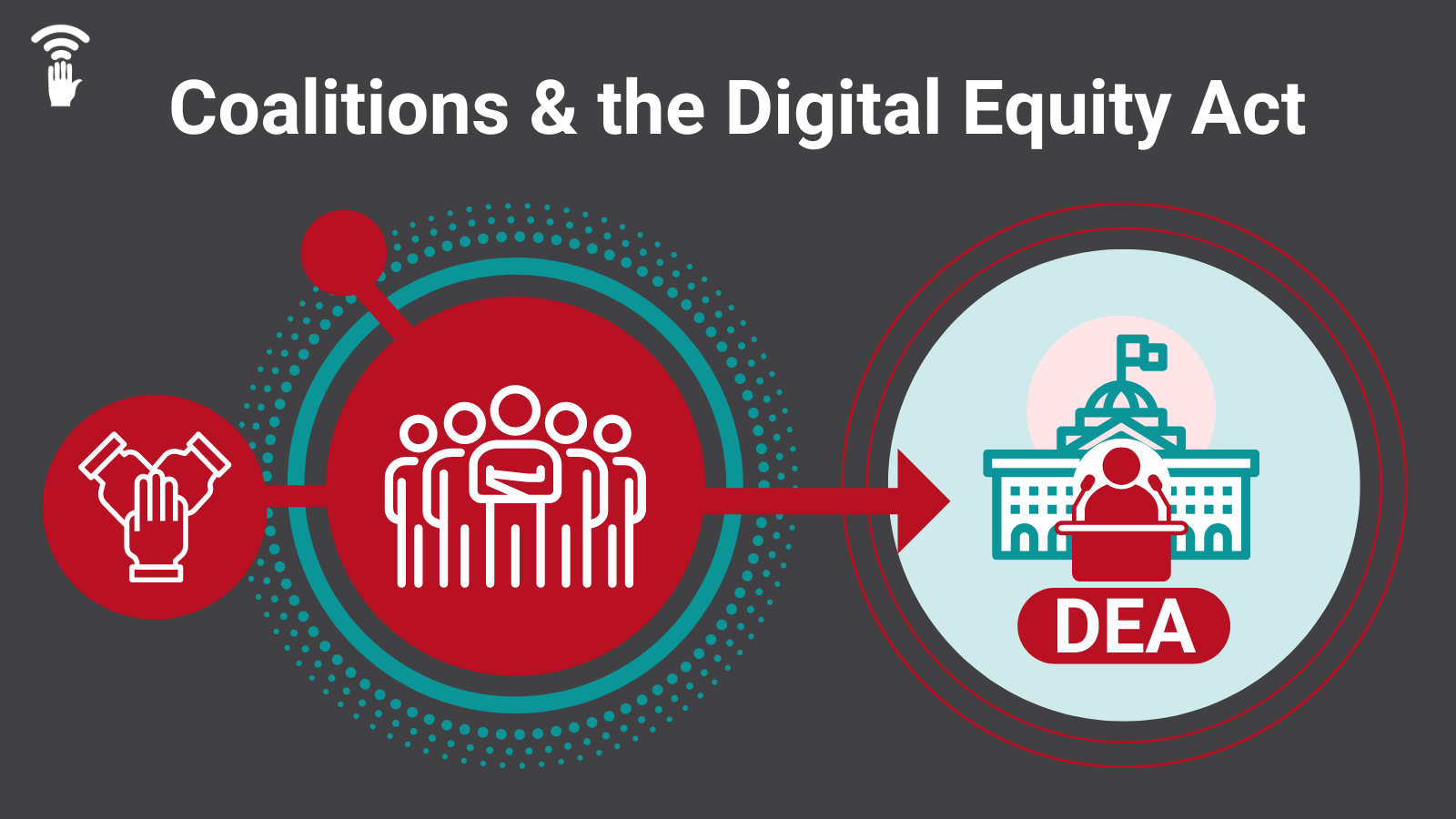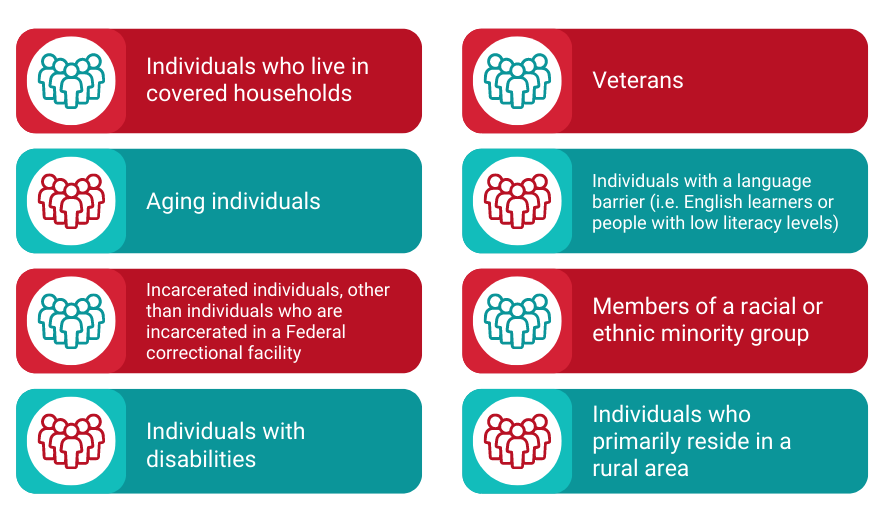
Local Digital Inclusion Coalitions Should Start Acting Now
This fall, states, territories, and the District of Columbia (DC) will receive Digital Equity Act (DEA) Planning Grant awards – and, with approximately a year to develop their state digital equity plan, they’ll start the process quickly.
The Infrastructure Act requires states, territories and DC (or the administering entities) to engage with a variety of stakeholders in creating the plan, including community anchor institutions, county and municipal governments, local educational agencies, and nonprofit organizations. The DEA Notice of Funding Opportunity further encourages states, territories, and DC to collaborate with digital inclusion coalitions, people with lived experiences encountering digital equity barriers, local foundations, and other stakeholders.
The bottom line: Administering entities need local input to develop the plans, and this is an opportunity for coalitions to partner with government leaders to support the development of an impactful digital equity plan.
Where Coalitions Can Add Value in DEA Plans
Digital inclusion coalitions offer valuable insight to most aspects of the state digital equity plan – from ideation to implementation. By bringing expertise and connections to members of the community, coalitions can support their state in building a digital equity plan that is informed by best practices and is responsive to the needs of diverse populations.
Visioning
State digital equity plans are required to articulate a vision for digital equity for the state/territory/district. The goals of the state digital equity plan emanate from the vision, so participation from digital inclusion advocates in this early stage will positively influence the plan’s direction. Coalitions that have developed a local digital equity vision can share input and key considerations from their process. Some administering entities may choose to develop the vision in the first few months of the planning process, others may wait until the end, but regardless, participating in this part of the planning process is vital.
Asset Mapping
Each administering entity must compile an inventory of digital equity resources for their plans. When done well, asset mapping is a participatory process that engages community members and organizations and that reflects not just discrete resources but a diverse network of assets and the connections between them.
Coalitions can contribute to this process by directing the administering entities to known digital equity assets, conducting their own asset mapping and sharing it with the state/territory/district, or by simply contributing information about coalition member organizations.
Identifying Barriers for Covered Populations
 Conducting an assessment of digital equity barriers helps from a baseline to work from and informs the objectives they will create to achieve the goals. State digital equity plans must identify the digital equity barriers faced by the general population, as well as barriers faced by members of covered populations. According to the DEA, “covered populations” refers the these groups:
Conducting an assessment of digital equity barriers helps from a baseline to work from and informs the objectives they will create to achieve the goals. State digital equity plans must identify the digital equity barriers faced by the general population, as well as barriers faced by members of covered populations. According to the DEA, “covered populations” refers the these groups:
- Aging individuals
- Incarcerated individuals, other than individuals who are incarcerated in a Federal correctional facility
- Veterans
- Individuals with disabilities
- Individuals with a language barrier, including individuals who are English learners and have low levels of literacy
- Individuals who are members of a racial or ethnic minority group
- Individuals who primarily reside in a rural area
- Individuals who live in covered households
To identify digital equity barriers, states/territories/DC need to characterize and quantify the digital equity needs and challenges facing each covered population using a combination of existing data sources and new primary data collection.
Coalitions can add value in multiple ways during this phase of the planning process by sharing locally collected data on digital equity barriers faced by covered populations, helping them reach covered populations, or even conducting local digital equity research that can be incorporated into the plan.
Objectives and Assessing Impact
Administering entities must include measurable objectives for addressing the barriers faced by the general population as well as covered populations – this is necessary for the state/territory/district to gauge its progress in accomplishing the goals of the digital equity plan in several specific areas:
- Broadband access and affordability
- Online accessibility of public resources
- Digital literacy
- Availability and affordability of devices
- An individual’s ability to protect their privacy online
The development of measurable objectives should be an iterative process – one that reflects ongoing input from digital inclusion practitioners, members of covered populations, and organizations representing them. Coalitions can serve as a bridge between state/territory/district and these communities, and support efforts to create measurable objectives that holistically address digital equity barriers.
Coalitions can also help states by sharing insights they’ve gained from their experiences developing and implementing local digital inclusion strategies and help anticipate factors that could facilitate or impede progress.
Implementation Strategies
State digital inclusion plans must also include implementation strategies that articulate how they will take action to achieve the measurable objectives and address digital equity barriers.
Coalitions can weigh in on multiple aspects of the state digital equity plan’s implementation strategies, via engagement opportunities throughout the plan’s development or through the public comment period for the draft plan (as required by statute) or both.
Coalitions can support the development of implementation strategies by helping the state/territory/district establish a forum for obtaining community feedback, so that the plans can be regularly evaluated and updated. Coalitions can also commit to becoming partners in implementing the plan and direct administering entities to other partners for support.
Coalitions Should Get Started Now
Whether newly formed or long-established, formal or informal, digital inclusion coalitions represent the alignment of a community’s digital equity capacity and knowledge.
Coalitions will be valuable partners to DEA administering entities over the next year and can meaningfully contribute to almost every aspect of state/territory/district digital equity plans. These are a few steps coalitions should pursue in the coming weeks:
- Find out who the Digital Equity Act Administering Entity is in your state, territory, or district and begin building, or strengthening, your connection. Invite them to attend or present at an upcoming coalition meeting or schedule a meeting for them to get to know the coalition’s leadership.
- Offer to share digital inclusion resources and best practices – many state broadband and digital equity office staff are new to their roles and even new to the digital inclusion field. They would appreciate guidance from experienced practitioners.
- Find out who will be leading the digital equity planning process (hint: it may or may not be the Administering Entity), and how the planning process will be structured. Some states have settled on a regional approach, some will hire consultants or universities, and others are still determining their process. The sooner you understand their approach to planning, the sooner you can identify opportunities for your coalition to engage and provide support.
- Compile local resources now so they are ready to contribute when the time is right. This could be a local digital equity plan, survey or other data you have collected, or simply a contact list of key organizations and individuals.
- Become a local information source about the state/territory/district digital equity plan. Begin distributing regular updates on the planning process to coalition members, local elected officials, nonprofit organizations, and the broader community. This will keep people informed and prepared to participate in the process – ensuring strong engagement and representation from your community – and it will establish your coalition as a trusted source of information.
